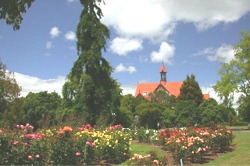Rotorua New Zealand Information
Home > New Zealand Information > Rotorua Information
Rotorua
From Wikipedia, the free encyclopaedia
| Rotorua | ||
|---|---|---|
| Urban Area | Population | 55,100 |
| Extent | Ngongotaha to Owhata | |
| Territorial Authority |
Name | Rotorua District |
| Population | 67,600 | |
| Extent | Mamaku to Lake
Golden Springs |
|
| Regional Council |
Name | Bay of Plenty |
Rotorua is a city located on the southern shore of Lake Rotorua in the Bay of Plenty region of the North Island of New Zealand. It has a population of 53,000.
The city is located 60 kilometres south of Tauranga, 105 km south-east of Hamilton and 82 km north-east of Taupo.
Rotorua is a spa resort, well-known for its geothermal activity in the area. There are a number of geysers (notably the 20 metre Whakarewarewa geyser) and hot mud pools located in the city that owe their presence to the Rotorua caldera.
History
The name Rotorua comes from the Maori_language. The full name is Rotorua-nui-a-Kahu. Roto generally means lake and rua meaning two. Literally translated Rotorua means second lake. It was named by the Maori chief Ihenga, as it was the second major lake that he discovered. The lake is the largest of a multitude found to the north and east of the city, all connected with the Rotorua Caldera and nearby Mount Tarawera.
The area was initially settled by Maori of the Te Arawa iwi. The lakeshore was a prominent site of skirmishes during the Maori wars of the 1860s. A "special town district" was created in the 1880s, in order to promote Rotorua's potential as a spa. Rotorua was established as a borough in 1922.
Tourism
Rotorua is home to not only geothermal interests, but botanical gardens and some interesting historical architecture. Known as a spa town and major tourist resort for close to a century, many of the buildings hint at this history. The formal Government Gardens close to the lakeshore at the eastern end of the town are particularly worth of note.
Kuirau Park, to the west end of the central city, is also remarkable - this for its natural features. hot bubbling mud pools dot the park, lending a surreal air to the setting.
Thermal activity is at the heart of much of Rotorua's tourist appeal. Geysers and bubbling mud-pools, hot thermal springs and even a buried village, Te Wairoa, are all located within easy reach of the city.
Rotorua was prominently featured in a music video by The Beastie Boys for their song Gratitude.




